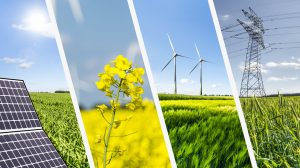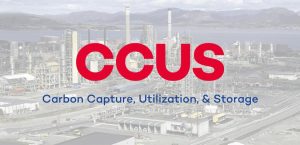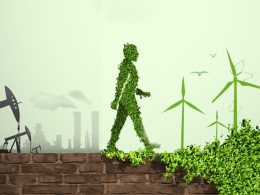The Role of Technology in Climate Change Mitigation
Climate change is a global challenge that is causing severe disruptions to the environment, economies, and societies worldwide. The need for urgent action to reduce greenhouse gas emissions and slow global warming has never been more pressing. While governments and organizations play critical roles, technology has become a central driver in addressing climate change. From renewable energy to carbon capture systems, technological innovations are proving to be crucial tools in mitigating the impact of climate change.
In this article, we will explore the role of technology in climate change mitigation, focusing on renewable energy, energy storage solutions, carbon capture technologies, sustainable agriculture, waste management, and sustainable transport.
1. Renewable Energy Technologies

One of the most powerful ways to mitigate climate change is by reducing our reliance on fossil fuels. Traditional energy sources, such as coal, oil, and natural gas, release vast amounts of carbon dioxide (CO2) and other greenhouse gases into the atmosphere. In contrast, renewable energy sources generate electricity without emitting harmful gases, making them essential to combating climate change.
Solar Power
Solar energy has become one of the most accessible and popular renewable energy sources. The cost of solar photovoltaic (PV) cells has significantly decreased in recent years, making solar energy more affordable and viable for both households and businesses. New technologies, such as bifacial solar panels, are capable of capturing sunlight from both sides of the panel, thereby increasing efficiency. Perovskite solar cells, an emerging technology, promise even higher efficiency rates and lower production costs. These advancements make solar energy a powerful tool in reducing carbon emissions.
Example: The United Arab Emirates (UAE) has made significant strides in solar energy development, with the Mohammed bin Rashid Al Maktoum Solar Park. This facility, once completed, will be one of the largest single-site solar parks in the world, capable of generating up to 5,000 MW of electricity. This initiative showcases how large-scale solar projects can contribute significantly to reducing fossil fuel consumption and mitigating climate change.
Wind Power
Wind power has also seen remarkable advancements, particularly in turbine technology. The development of larger and more efficient turbines has led to a substantial increase in wind energy generation worldwide. Offshore wind farms, in particular, are expected to be a key player in the future energy mix. With higher wind speeds at sea, these farms can generate more electricity.
Case Study: The London Array, located in the North Sea, is one of the world’s largest offshore wind farms. It has a total capacity of 630 MW and can power up to 500,000 homes, helping to reduce CO2 emissions by over 900,000 tons annually. The growth of offshore wind technology is setting a global precedent for large-scale renewable energy projects.
2. Energy Storage Solutions
Despite the advantages of renewable energy, challenges remain, particularly with the intermittency of solar and wind power. Energy storage technologies are essential for balancing supply and demand, ensuring that clean energy is available even when the sun isn’t shining or the wind isn’t blowing.
Battery Technologies
Advances in battery technology have significantly improved energy storage capabilities. Lithium-ion batteries, commonly used in electric vehicles and renewable energy systems, have become more efficient and cost-effective. Solid-state batteries, which are safer and more efficient than traditional lithium-ion batteries, are also gaining traction.
Example: Tesla’s Powerwall is an innovative energy storage solution that allows homeowners and businesses to store energy generated by solar panels. This stored energy can be used during periods of high demand or when solar generation is low, enabling users to reduce their reliance on fossil fuels.
Pumped Hydro Storage and Flow Batteries
In addition to traditional batteries, other energy storage technologies such as pumped hydro storage (PHS) and flow batteries are being explored. PHS involves storing energy by pumping water uphill to a reservoir, where it can later be released to generate electricity when needed. Flow batteries, on the other hand, use liquid electrolytes to store energy, offering longer-lasting solutions for large-scale energy storage.
3. Carbon Capture, Utilization, and Storage (CCUS)

Some industries, such as cement, steel, and chemical manufacturing, are hard to decarbonize due to their high emissions. Carbon capture, utilization, and storage (CCUS) technologies are playing a vital role in reducing CO2 emissions from these industries by capturing and storing carbon before it enters the atmosphere.
Direct Air Capture (DAC)
Direct Air Capture (DAC) is an emerging technology that extracts CO2 directly from the atmosphere. Once captured, the CO2 can be stored underground or used to produce synthetic fuels. While DAC is still in its infancy, it offers a promising solution for reducing atmospheric CO2 levels.
Example: Climeworks, a Swiss company, operates one of the largest DAC plants in the world, which captures around 900 tons of CO2 annually. The captured CO2 is then either stored underground or used in products like carbon-neutral fuels and fertilizers. Such technologies, though costly, hold significant potential in reversing some of the damage done by years of carbon emissions.
Carbon Sequestration
Another essential aspect of CCUS is carbon sequestration, which involves storing captured CO2 deep underground in geological formations, where it can remain for thousands of years. This process helps prevent CO2 from entering the atmosphere and contributing to global warming.
Case Study: The Petra Nova project in Texas, USA, is one of the world’s largest carbon capture projects. It captures around 1.6 million tons of CO2 per year from a coal-fired power plant and stores it in deep underground reservoirs. This project demonstrates how carbon capture and storage technologies can be applied to existing infrastructure to significantly reduce emissions.
4. Sustainable Agriculture and Food Systems

Agriculture is both a significant contributor to greenhouse gas emissions and one of the sectors most affected by climate change. Technological innovations in farming practices are helping reduce emissions while also increasing food production to meet the needs of a growing global population.
Precision Agriculture
Precision agriculture involves using advanced technologies such as drones, sensors, and satellite imaging to optimize crop management. By monitoring soil health, weather patterns, and crop conditions in real-time, farmers can reduce the use of water, fertilizers, and pesticides, minimizing environmental impacts and improving crop yields.
Example: John Deere, a leading agricultural machinery company, has developed a range of precision farming tools, including autonomous tractors and harvesters. These technologies help farmers optimize their operations, reduce waste, and enhance sustainability.
Plant-Based and Lab-Grown Meat
Another innovative approach in sustainable agriculture is the development of plant-based proteins and lab-grown meat. By producing meat alternatives with far fewer resources and lower emissions than traditional livestock farming, these technologies offer a more sustainable way to feed the world.
Case Study: Impossible Foods and Beyond Meat are pioneers in the plant-based meat industry. Their products, made from ingredients like soy and pea protein, have a fraction of the environmental impact of traditional beef production. Lab-grown meat companies, such as Memphis Meats, are also making strides in producing cultured meat with much lower emissions and water usage than conventional animal farming.
5. Waste Management and Circular Economy Technologies
The circular economy focuses on reducing waste and reusing resources instead of discarding them. Waste management technologies are evolving to support this model by turning waste into valuable products and energy.
Recycling Innovations
Technological advancements in recycling are making it possible to recover more materials from waste, reducing the need for virgin resources. Chemical recycling, for example, allows plastics to be broken down into their original components and reused, significantly reducing plastic waste and its environmental impact.
Example: In Europe, the Netherlands-based company Renewi operates a waste-to-product model, where they process over 14 million tons of waste annually and recycle materials into new products, reducing emissions and supporting a circular economy.
Waste-to-Energy Systems
Waste-to-energy (WTE) technologies convert waste materials into usable energy. These systems help reduce methane emissions from landfills and generate electricity, providing a renewable energy source from organic waste.
Case Study: The Javelin Hill Waste-to-Energy Plant in Washington, DC, processes around 2,000 tons of waste each day and generates over 50 MW of electricity. This process reduces landfill waste while generating renewable energy, contributing to the city’s overall sustainability goals.
6. Sustainable Transport Technologies
Transportation is a major source of CO2 emissions, but technology is driving innovation in the sector to reduce its environmental footprint.
Electric Vehicles (EVs)
Electric vehicles are becoming increasingly popular as a cleaner alternative to gasoline and diesel-powered vehicles. Advances in battery technology have made EVs more affordable, with longer ranges and faster charging times. As EV adoption continues to grow, transportation emissions will decrease significantly.
Example: Tesla, a leader in the EV market, has revolutionized the automotive industry with its electric cars, such as the Model 3, which have become highly popular due to their performance, range, and environmental benefits. Other companies like Nissan, BMW, and Ford are following suit, making EVs more accessible to consumers.
Hydrogen-Powered Transport
Hydrogen fuel cell vehicles are another exciting development in sustainable transport. Hydrogen-powered vehicles emit only water vapor as a byproduct, making them a clean alternative to traditional vehicles.
Case Study: Toyota’s Mirai is one of the first hydrogen-powered cars available to consumers. It uses a fuel cell to generate electricity from hydrogen gas, offering a zero-emission alternative to gasoline-powered cars.
Conclusion
Technology plays an essential role in mitigating the impact of climate change. From renewable energy sources to innovative recycling methods, the advancements in clean technologies are transforming industries and providing solutions to reduce emissions. As we continue to develop and scale these technologies, we can hope for a more sustainable future. However, for these technologies to be truly effective, they need to be integrated into global policies and supported by governments, businesses, and individuals alike. The future of climate change mitigation rests in our collective ability to harness the potential of technology to protect the planet for future generations.
FAQs
1. How do renewable energy technologies reduce climate change?
Renewable energy sources like solar and wind generate electricity without emitting greenhouse gases, reducing our dependence on fossil fuels and helping to mitigate climate change.
2. What is the role of carbon capture technology in climate change mitigation?
Carbon capture technology captures CO2 from industrial processes and power plants and either stores it underground or repurposes it, preventing it from entering the atmosphere.
3. Can electric vehicles help reduce climate change?
Yes, electric vehicles produce zero emissions at the point of use, significantly reducing greenhouse gas emissions compared to traditional gasoline-powered cars.
4. What is precision agriculture, and how does it help the environment?
Precision agriculture uses technology to optimize farming practices, reducing the use of water, fertilizers, and pesticides, which helps minimize environmental damage.
5. How can waste-to-energy technologies contribute to climate change mitigation?
Waste-to-energy technologies convert waste materials into renewable energy, reducing landfill waste and generating electricity without emitting harmful pollutants.









